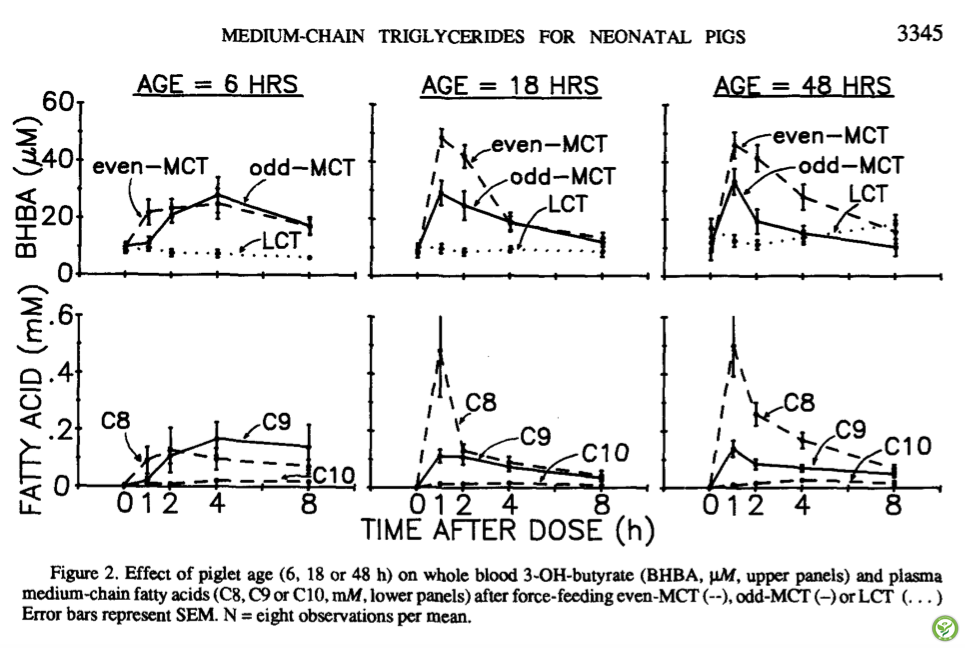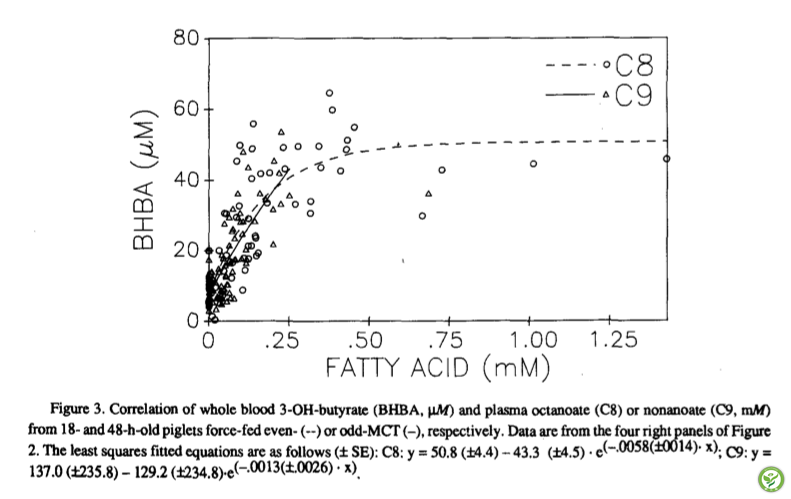当前位置:首页> >肠动力研究院> >技术文章> > 技术文章
第11期 初生仔猪对中链脂肪酸甘油酯的利用:II.出生后前两天仔猪服用偶数碳和奇数碳中链脂肪酸甘油
Utilization of medium-chain triglycerides by neonatal piglets: II. Effects of even- and odd-chain triglyceride consumption over the first 2 days of life on blood metabolites and urinary nitrogen excretion.
作者:J. Odle 2,3 , N.J.Benevenga2,3 and T.D. Crenshaw2
University of Wisconsin, Madison 53706
来源:J. Anim. Sci. 1989. 67:3340-3351
翻译:肠动力研究院
【摘要】:在两个实验中,144头初生仔猪强饲12ml含有偶数碳(C8,C10)或奇数碳(C7,C9)的中链脂肪酸甘油酯(偶数-MCT,奇数MCT)、长链(C≥16)脂肪酸甘油酯(LCT)。为测定尿氮排出和血液代谢产物,仔猪单独笼养24小时。实验1中,仔猪出生后不哺乳且立即强饲。与给予12ml水的对照组相比,服用甘油三酯的仔猪降低了24小时尿氮的排出,意味着降低了机体蛋白分解和提高了能量储备。所有仔猪24小时内的血糖水平显著提高(P<0.05),但是,MCT组的血糖水平(1.38mM)比LCT组(0.61mM)和对照组(0.85mM)要高,偶数碳-MCT组血糖水平(1.87mM)比奇数碳-MCT组(1.14mM)要高。在实验2 中,仔猪哺乳,在出生后6、18、48小时强饲。在出生6和18小时之间,偶数碳-MCT的利用率明显提高;服用1小时后,血浆中两倍vs6倍的3-羟基-丁酸(BHBA)浓度的增加和两倍vs12倍的血浆脂肪酸浓度的增加印证了这一点。在奇数-MCT组的仔猪中没有发现类似结果。在仔猪出生18和48小时,奇数-MCT对3-羟基-丁酸(BHBA)影响大约只有偶数碳-MCT的一半,在出生6小时没有影响。在仔猪出生6,18和48小时,强饲LCT对3-羟基-丁酸(BHBA)的浓度没有影响(P>0.1)。综合来看,数据显示:MCT比LCT的利用率要高;偶数碳-MCTvs奇数碳-MCT的利用是有差异的,取决于初生日龄。这也可能是与碳链长度对消化和吸收的影响相关,因为即使含有25%的偶数碳-MCT的添加,血浆癸酸盐浓度变化很小。
【关键词】:仔猪 新生仔猪 中链脂肪酸甘油酯 奇数碳脂肪酸 酮体 提高
以下是实验中相关图表
表1.甘油三酯的脂肪酸组成

图1.C8. C9. C10色谱分析

表2.初生仔猪强饲不同脂肪酸组成的甘油三酯对血液尿素和血糖水平、机体失重、氮排出的影响。

图2.强饲偶数碳-MCT、奇数碳-MCT、长链脂肪酸-LCT后,日龄在(6,18,48小时)的仔猪总血液3-羟基-丁酸(BHBA,uM,上半部分图表)和血浆中链脂肪酸(C8,C9或者C10,mM,下半部分图表)的影响

图3. 仔猪强饲偶数 碳-MCT和奇数碳-MCT后,出生18小时和48小时,总血液3-羟基-丁酸(BHBA,uM)和血浆C8,C9的相关性。

建议
本实验提供了新生仔猪能很好地利用MCT和MCT的利用能提高仔猪第一天的成活率的有力证据。强饲MCT后中链脂肪酸和3-羟基-丁酸的浓度估值是瞬时变化的,且源自12mlMCT代谢的能量无法获知。本实验也提出一个概念:甘油三酯的脂肪酸碳链长度的变化、偶数的中链脂肪酸族(C6-C2),可能对新生仔猪的利用速率和利用程度产生较大影响。这些推论仅限于用于本实验中的均重为(1325±160g)的仔猪。未来的研究应该聚焦于低出生重的仔猪的代谢能力。
Abstract
In two experiments, 144 neonatal pigs were force-fed 12 ml of triglyceride containing fatty acids of even (C8, C10) or odd (C7, C9) medium-chain length (even-MCT, odd-MCT, respectively) or long- (_>C16) chain length (LCT). Pigs were individually caged for measurement of urinary N excretion and(or) blood metabolites over 24 h. In Exp. 1, pigs were force-fed immediately after birth and were not allowed to suckle. Supplementation with triglyceride decreased 24-h N excretion compared with control animals given 12 ml of water, suggesting decreased breakdown of body protein and improved energy status. Blood glucose increased over 24 h in all pigs (P < .05), but more in pigs given MCT (1.38 raM) than in those given LCT (.61 mM) or in controls (.85 mM) and more in animals given even-MCI" (1.87 mM) than in those given odd-MCT (1.14 mM). In Exp. 2, pigs were allowed to suckle and were force-fed at 6, 18 or 48 h of age. An apparent improvement in utilization of even-MCT was observed between 6 and 18 h, as evidenced by a twofold vs a sixfold increase in 3-OH-butyrate (BHBA) concentration 1 h after dosing and a twofold vs
12-fold increase in plasma fatty acid concentration. This was not seen in pigs given odd- MCT. The BHBA response with odd-MCT was approximately half that observed with even-MCT in pigs 18 and 48 h old, but not in pigs 6 h old. No change in BHBA concentration (P > .1) was observed in pigs after force-feeding LCT at either 6, 18 or 48 h of age. Collectively, these data suggest that MCT may be better utilized than LCT and that there may be a differences in the utilization of even-MCT vs Odd-MCT, depending on the age of the neonate. This could be related to chain length effects on digestion and absorption because plasma decanoate concentration changed very little, even though it composed 25% of the even-MCT supplement.
Keywords:Piglets, Neonates, Medium-Chain Triglycerides, Odd-Chain Fatty Acids, Ketone Bodies, Development.
Implications
The experiments reported herein provide evidence that MCT can be utilized by newborn piglets and that this utilization may improve over the 1st d of life. The evaluation in concentration of MCFA and BHBA after force-feeding MCT were very transient, and the amount of metabolic fuel obtained from a single 12-ml dose is unknown. This work also has raised the notion that changes in fatty acid chain length of triglycerides, even within the medium-chain family (C6 to C12), may have profound effects on their rate and extent of utilization by the neonatal piglet. These inferences must be limited to the piglets of average birth weight (1,325 + 160g; mean + SD) used in this work. Future research should focus on the metabolic competency of piglets of low birth weight.
如您需原文,请联系本文作者和出版方,或请垂询肠动力研究院。本网站发布的所有资料将尽最大可能注明出处、作者及日期,如无意中侵犯了您的知识产权,请来信及时告知,我们将立即予以删除。
All information released by the WeChat Official Account will do its best to indicate the source, author and date. If we inadvertently infringe on your intellectual property, please inform us in time and we will delete it immediately.